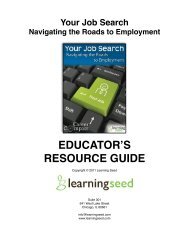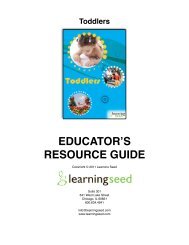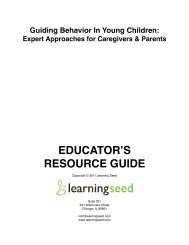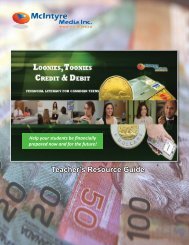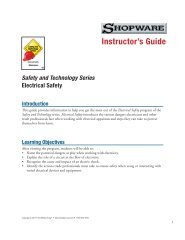Buying into Brand Marketing: EDUCATORʼS ... - Learning Seed
Buying into Brand Marketing: EDUCATORʼS ... - Learning Seed
Buying into Brand Marketing: EDUCATORʼS ... - Learning Seed
You also want an ePaper? Increase the reach of your titles
YUMPU automatically turns print PDFs into web optimized ePapers that Google loves.
<strong>Buying</strong> <strong>into</strong> <strong>Brand</strong> <strong>Marketing</strong>:<br />
Shaping Your Perceptions<br />
<strong>EDUCATORʼS</strong><br />
RESOURCE GUIDE<br />
Copyright © 2012 <strong>Learning</strong> <strong>Seed</strong><br />
Suite 301<br />
641 West Lake Street<br />
Chicago, IL 60661<br />
info@learningseed.com<br />
www.learningseed.com
Whatʼs in this Guide...and How to Use It!<br />
Program Overview • Video chapter titles and key concepts p. 3<br />
Before & After<br />
Viewing the Program<br />
• Prompts for writing or discussion<br />
R Use prompts to initiate a:<br />
- class discussion<br />
- pair-share (partners discuss the prompt; each partner<br />
reports one of the other personʼs ideas)<br />
- quick-write (unplanned, written response)<br />
• Suggested activities to extend learning<br />
Graphic Organizer • Tool for taking notes during the video p. 5<br />
Check Your<br />
Understanding<br />
• Short-answer questions. Can be used:<br />
R - during the video to keep students on track<br />
- after the video for in-class review or assessment<br />
- after the video as homework<br />
p. 4<br />
pp. 6-7<br />
• Answer key pp. 8-9<br />
Assessment • Quiz - Fill-in-the-Blank p. 10<br />
• Answer key p. 11<br />
Glossary • Definitions of key words and phrases from the video p. 12<br />
Educatorʼs<br />
Resources<br />
• National Standards addressed in the video<br />
• Useful Internet resources<br />
p. 13<br />
Legal Niceties • What you can do, and what you shouldnʼt p. 14<br />
Related <strong>Learning</strong> <strong>Seed</strong> Programs<br />
• Supermarkets: Aisles of Persuasion<br />
• <strong>Marketing</strong> 4 Ps: The Consumer Angle<br />
• How Consumers Decide<br />
#<br />
# <strong>Buying</strong> <strong>into</strong> <strong>Brand</strong> <strong>Marketing</strong>: Shaping Your Perceptions<br />
• Blind Spots & Biases: Hidden Forces That Shape Your Decisions<br />
Copyright 2012 <strong>Learning</strong> <strong>Seed</strong> " 2
Program Overview<br />
In order to shape consumersʼ perceptions, companies spend huge amounts of money<br />
marketing their brands. This program examines why and how a brand is created, from its<br />
name, logo, and packaging to its image and messaging. Viewers learn how marketing targets<br />
certain groups of people and how consumers can make informed purchasing decisions.<br />
Chapter 1 – What is <strong>Brand</strong> <strong>Marketing</strong>?<br />
• The purpose of brand marketing is to persuade consumers to buy one brandʼs product over<br />
other similar products and to develop in those consumers a loyalty to the brand.<br />
• <strong>Brand</strong> marketing aims to convince consumers that a “want” is actually a “need.”<br />
Chapter 2 – A <strong>Brand</strong> by Any Other Name<br />
• <strong>Brand</strong> identity includes name, logo, visual representations, and messaging.<br />
• Advertising and strategies like contests build brand awareness and are part of the brand<br />
experience. <strong>Brand</strong> experience can be categorized as controlled and uncontrolled.<br />
• <strong>Brand</strong> identity and brand experience contribute to a brandʼs image.<br />
Chapter 3 – Playing the Game<br />
• Companies build a brand strategy – their long-term plan for getting and keeping customers.<br />
• Companies identify and target certain groups as potential consumers of their brand.<br />
• Positioning is a strategy aimed at setting a product apart from its competitors and connecting<br />
with consumers on a personal or emotional level.<br />
• Messaging is the words marketers use to describe a brand and include catchy slogans.<br />
Chapter 4 – Look Beyond the <strong>Brand</strong><br />
• When faced with a purchasing decision, consumers should consider whether the product is a<br />
need or a want and whether theyʼre being overly influenced by a brandʼs image or message.<br />
Chapter 5 - Conclusion<br />
#<br />
# <strong>Buying</strong> <strong>into</strong> <strong>Brand</strong> <strong>Marketing</strong>: Shaping Your Perceptions<br />
Copyright 2012 <strong>Learning</strong> <strong>Seed</strong> " 3
Before and After<br />
Prompts to generate interest, ideas, and inquiry<br />
Before viewing<br />
To spark interest, activate prior knowledge, and set a purpose for viewing<br />
• Do you always buy the same brand of a certain product, for example, jeans, shampoo, or<br />
phones? Why did you buy that brand the first time, and why do you keep buying it?<br />
After viewing<br />
To promote critical thinking<br />
• The program mentioned that some companies spend half of a productʼs purchase price on<br />
marketing. Should customers resent the fact that they are paying to have a product<br />
marketed to them, or should they accept this as a necessary part of a competitive market?<br />
• Think of a promotion (i.e., a TV commercial, billboard, or website) that made you NOT want<br />
to buy a product and briefly explain your negative reaction to the promotion. Be sure to<br />
address marketing elements such as brand image, brand experience (images and/or<br />
sound), trade characters, and messaging.<br />
• List four different personal care products you use regularly. Next to each one, write whether<br />
it is a “want” or a “need.” Explain how you decided on the category for each product. Why<br />
can it be hard to distinguish wants from needs? Does advertising influence you?<br />
After viewing<br />
To extend learning<br />
#<br />
# <strong>Buying</strong> <strong>into</strong> <strong>Brand</strong> <strong>Marketing</strong>: Shaping Your Perceptions<br />
• Ask small groups to identify a branded product that has been around for at least 10 years.<br />
Direct groups to online tools to research changes in the productʼs marketing. (Many<br />
company websites include information on the history of their products.) Groups may want to<br />
have members focus on different elements such as logo, target audience, message, and<br />
jingle. Research on popular culture trends may help students explain the changes.<br />
• Give students the opportunity to build a brand image for a product commonly used by their<br />
peer group (personal care, food, clothing, technology). Working in pairs or teams, direct<br />
students to develop elements of the brandʼs identity (name, logo, packaging, and<br />
messaging – even a jingle). They should also come up with an idea for creating a brand<br />
experience and brand awareness. A poster or Powerpoint presentation would be a good<br />
format for sharing their work.<br />
Copyright 2012 <strong>Learning</strong> <strong>Seed</strong> " 4
Name<br />
Date<br />
#<br />
# <strong>Buying</strong> <strong>into</strong> <strong>Brand</strong> <strong>Marketing</strong>: Shaping Your Perceptions<br />
_________________________________________________________________<br />
____________________________________ Class Period _______________<br />
While You Watch...use the graphic organizer to record key words and information.<br />
<strong>Brand</strong> Identity:<br />
Includes:<br />
<strong>Brand</strong> Experience:<br />
Includes:<br />
2 categories:<br />
Positioning:<br />
Messaging:<br />
A brand is....<br />
Building a <strong>Brand</strong><br />
<strong>Brand</strong> Image<br />
<strong>Marketing</strong><br />
Copyright 2012 <strong>Learning</strong> <strong>Seed</strong> " 5
Name<br />
Date<br />
#<br />
# <strong>Buying</strong> <strong>into</strong> <strong>Brand</strong> <strong>Marketing</strong>: Shaping Your Perceptions<br />
_________________________________________________________________<br />
____________________________________ Class Period _______________<br />
Check Your Understanding<br />
Write short answers for the following questions about the video:<br />
1. Why has branding become so important for products in todayʼs world?<br />
2. What are the two ways of measuring advertising, and what do they mean?<br />
3. How does the government protect companies with respect to branding?<br />
4. What are the two categories of brand experiences? Give an example of each.<br />
5. What important part of brand marketing do brand identity and brand experience contribute<br />
to?<br />
Copyright 2012 <strong>Learning</strong> <strong>Seed</strong> " 6
#<br />
# <strong>Buying</strong> <strong>into</strong> <strong>Brand</strong> <strong>Marketing</strong>: Shaping Your Perceptions<br />
Check Your Understanding (continued)<br />
6. Give three examples of target markets.<br />
7. What is positioning, and how is it supposed to affect consumers?<br />
8. What are some ways a brandʼs message can be delivered? Name at least two.<br />
9. Why are brands sometimes useful?<br />
10.What are two things consumers should consider or do before making a purchase?<br />
Copyright 2012 <strong>Learning</strong> <strong>Seed</strong> " 7
Check Your Understanding Answer Key<br />
Correct answers appear in italics.<br />
1. Why has branding become so important for products in todayʼs world?<br />
Because the marketplace is crowded with so many similar products.<br />
2. What are the two ways of measuring advertising, and what do they mean?<br />
”Reach,” which refers to how many people will see the ad; and “frequency,”<br />
which refers to how many times they will see it.<br />
3. How does the government protect companies with respect to branding?<br />
There are laws that make it illegal to copy a brandʼs name, logo, trade character,<br />
and visual style.<br />
4. What are the two categories of brand experiences? Give an example of each.<br />
Controlled and Uncontrolled.<br />
Examples of controlled experiences: logos, retail environments, and TV ads.<br />
Examples of uncontrolled experiences: the consumer trying a product and not liking it, or<br />
having difficulty getting it.<br />
5. What important part of brand marketing do brand identity and brand experience contribute<br />
to?<br />
<strong>Brand</strong> image.<br />
#<br />
# <strong>Buying</strong> <strong>into</strong> <strong>Brand</strong> <strong>Marketing</strong>: Shaping Your Perceptions<br />
Copyright 2012 <strong>Learning</strong> <strong>Seed</strong> " 8
#<br />
# <strong>Buying</strong> <strong>into</strong> <strong>Brand</strong> <strong>Marketing</strong>: Shaping Your Perceptions<br />
Check Your Understanding Answer Key (continued)<br />
6. Give three examples of target markets.<br />
Many possible answers, such as: working moms, Hispanic teenagers, cat owners,<br />
teen boys.<br />
7. What is positioning, and how is it supposed to affect consumers?<br />
It is a strategy to make a brand stand out or seem different from similar products.<br />
Positioning tries to appeal to consumers on an emotional or personal level.<br />
8. What are some ways a brandʼs message can be delivered? Name at least two.<br />
Possible answers: TV ads, brochures, websites, billboards, business cards, store displays.<br />
9. Why are brands sometimes useful?<br />
Possible answers:<br />
When a brand has earned a consumerʼs trust, it can make shopping easier.<br />
<strong>Brand</strong>s can help you know what youʼre getting before you buy.<br />
<strong>Brand</strong> marketing can introduce consumers to new and useful items.<br />
10.What are two things consumers should consider or do before making a purchase?<br />
Possible answers:<br />
Consider whether the product is a need or a want.<br />
Consider whether the productʼs value matches its image.<br />
Make sure itʼs in their interest to buy what the brand is selling.<br />
Research the companyʼs values and practices.<br />
Research what other brands are available.<br />
Compare prices.<br />
Copyright 2012 <strong>Learning</strong> <strong>Seed</strong> " 9
Name<br />
Date<br />
_________________________________________________________________<br />
____________________________________ Class Period _______________<br />
Fill In the Blank...with the word or phrase that best completes the sentence.<br />
1. The corporate world sees people primarily as ___________________.<br />
2. Goods and services essential to survival are called ___________________.<br />
3. Putting a name or symbol on a product to show ownership is called _________________.<br />
4. The process of promoting, selling and distributing a product is ___________________.<br />
5. The entire outward expression of a brand, including name and message, is its<br />
___________________.<br />
6. A graphic mark or symbol that identifies the brand is the ___________________.<br />
7. A common tactic for building brand awareness is ___________________.<br />
8. The group of people a company is trying to get to buy its product is the<br />
___________________.<br />
9. The words marketers use to describe a brand are called ___________________.<br />
10. The way marketers get consumers to view a brand relative to its competitors is<br />
___________________.<br />
#<br />
# <strong>Buying</strong> <strong>into</strong> <strong>Brand</strong> <strong>Marketing</strong>: Shaping Your Perceptions<br />
Word Bank (There is one extra word.)<br />
positioning brand identity consumers messaging branding logo<br />
advertising target market needs marketing brand loyalty<br />
BONUS: Use the extra word in a sentence that gives information from the video.<br />
_______________________________________________________________________<br />
_____________________________________________________________________________________<br />
Copyright 2012 <strong>Learning</strong> <strong>Seed</strong> " 10
Name<br />
Date<br />
#<br />
# <strong>Buying</strong> <strong>into</strong> <strong>Brand</strong> <strong>Marketing</strong>: Shaping Your Perceptions<br />
_________________________________________________________________<br />
____________________________________ Class Period _______________<br />
"<br />
Fill In the Blank...Answer Key<br />
Correct answers appear in bold-face type.<br />
1. The corporate world sees people primarily as consumers.<br />
2. Goods and services essential to survival are needs.<br />
3. Putting a name or symbol on a product to show ownership is called branding.<br />
4. The process of promoting, selling and distributing a product is marketing.<br />
5. The entire outward expression of a brand, including name and messaging, is its<br />
brand identity.<br />
6. A graphic mark or symbol that identifies the brand is the logo.<br />
7. A common tactic for building brand awareness is advertising.<br />
8. The group of people a company is trying to get to buy its product is the target market.<br />
9. The words marketers use to describe a brand are called messaging.<br />
10. The way marketers get consumers to view a brand in relation to its competitors is<br />
positioning.<br />
Word Bank (There is one extra word.)<br />
positioning brand identity consumers messaging branding logo<br />
advertising target market needs marketing brand loyalty<br />
BONUS: Use the extra word in a sentence that gives information from the video.<br />
Companies want to build brand loyalty so consumers will trust in their brand and buy it<br />
without thinking – for their whole lives. # " " " " " " " " " " " " " " "<br />
Copyright 2012 <strong>Learning</strong> <strong>Seed</strong> " 11
Glossary<br />
#<br />
# <strong>Buying</strong> <strong>into</strong> <strong>Brand</strong> <strong>Marketing</strong>: Shaping Your Perceptions<br />
advertising Communication used to persuade a specific audience to make a<br />
purchase or take an action.<br />
brand Name, sign, symbol or slogan that identifies and distinguishes specific<br />
products from a specific seller.<br />
brand awareness Extent to which the public is aware of a product, company or brand.<br />
brand experience Everything a consumer gets from visual, verbal and experiential<br />
encounters with the brand.<br />
brand image Psychological aspect of a consumerʼs impression of a brand,<br />
regardless of experience.<br />
consumer Anyone who uses goods and services.<br />
logo Graphic mark or symbol that identifies a brand.<br />
marketing Process of promoting, selling, and distributing a product or service.<br />
messaging Words marketers use to describe a brand.<br />
positioning Strategy of setting a product apart from other similar products by<br />
creating images in the consumerʼs mind that appeal to emotions or<br />
feelings.<br />
trade characters People, animals, animated characters or objects used in advertising a<br />
brand.<br />
visual identity <strong>Brand</strong>ʼs visible elements that convey meaning without words, such as<br />
its logo, shape, and packaging.<br />
Copyright 2012 <strong>Learning</strong> <strong>Seed</strong> " 12
Resources for Educators<br />
Educational Standards<br />
Family and Consumer Sciences - National Standards<br />
Consumer and Family Resources<br />
2.1 Demonstrate management of individual and family resources, including food,<br />
clothing, shelter, health care, recreation, and transportation.<br />
2.5 Analyze interrelationship between the economic system and consumer actions.<br />
2.6 Demonstrate management of financial resources to meet the goals of individuals<br />
and families across the life span.<br />
National Business Education Association - National Standards<br />
MK2 Analyze the characteristics, motivations, and behaviors of consumers.<br />
MK4 Analyze the elements of the marketing mix, their interrelationships, and how they are<br />
used in the marketing process.<br />
MK5 Analyzes the role of marketing research in decision making.<br />
MK6 Describes the elements, design, and purposes of a marketing plan.<br />
Useful Internet Resources<br />
#<br />
# <strong>Buying</strong> <strong>into</strong> <strong>Brand</strong> <strong>Marketing</strong>: Shaping Your Perceptions<br />
• Advertising Standards Authority<br />
asa.org.uk<br />
Sponsored by the independent regulator of advertising across all media in the UK, this site includes a<br />
webcast on digital advertising, information on how to spot ads in digital space, and a study about the<br />
appropriateness of ads directed at young people— “Advertising and Young People” — which<br />
compares teacher, parent, and student perceptions of ads.<br />
• Federal Trade Commission – Bureau of Consumer Protection<br />
ftc.gov/bcp<br />
The “Whatʼs New” section provides the latest news on advertising scams. Students can also visit a<br />
virtual mall to learn about advertising techniques, target marketing, suspicious claims, and bogus<br />
offers. Click on the “Consumer Protection” tab, then go to “Consumer Information” to enter the mall.<br />
• Media Awareness Network<br />
media-awareness.ca<br />
This site offers workshops and lesson plans for teachers on topics such as the way marketers use<br />
sports and athletes to influence young people. For parents, “Advertising – Itʼs Everywhere” offers<br />
information about market strategies. A study published here found that 94% of the top 50 websites for<br />
young people include marketing material.<br />
Copyright 2012 <strong>Learning</strong> <strong>Seed</strong> " 13
Legal Niceties<br />
WHAT CAN I DO WITH THIS RESOURCE GUIDE?<br />
Copyright © 2012 <strong>Learning</strong> <strong>Seed</strong><br />
This resource guide is copyrighted according to the terms of the Creative Commons non-commercial<br />
license (http://creativecommon.org/licenses/by-nc/2.5/). It may be reproduced, in its part or its entirety, for<br />
classroom use. No part of this guide may be reproduced for sale by any party.<br />
You are free:<br />
• to copy, distribute, display, and perform this work.<br />
• to make derivative works.<br />
Under the following conditions:<br />
• Attribution. You must attribute the work to <strong>Learning</strong> <strong>Seed</strong>.<br />
• Noncommercial. You may not use this work for commercial purposes.<br />
• For any reuse or distribution, you must make clear to others the license terms of this work.<br />
Any of these conditions can be waived if you get permission from the copyright holder.<br />
Resource Guide Credits<br />
Writer: Esther Mosak<br />
Editor: Jodi Libretti<br />
Copy Editor(s): Jennifer Smith<br />
WHAT CAN I DO WITH THE VIDEO?<br />
Copyright © 2012 <strong>Learning</strong> <strong>Seed</strong><br />
This video is protected under U.S. copyright law. No part of this video may be reproduced or transmitted<br />
by any means, electronic or mechanical, without the written permission of the Publisher, except where<br />
permitted by law.<br />
DVD LS-1244-12-DVD ISBN 978-1-55740-609-5<br />
Closed Captioning<br />
This program is closed captioned.<br />
#<br />
# <strong>Buying</strong> <strong>into</strong> <strong>Brand</strong> <strong>Marketing</strong>: Shaping Your Perceptions<br />
Questions, suggestions, or comments?<br />
E-mail us at info@learningseed.com or call 800.634.4941<br />
Copyright 2012 <strong>Learning</strong> <strong>Seed</strong> " 14




